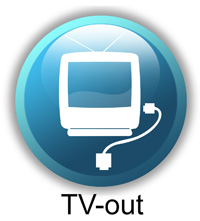TV-Output
HIS Technology, January 1, 2008
 S-Video is commonly used throughout the world. It is found on consumer TVs, DVD players, high-end video cassette recorders, Digital TV receivers, DVRs, and game consoles. Almost all TV-out connectors on graphics cards can support S-Video.
S-Video is commonly used throughout the world. It is found on consumer TVs, DVD players, high-end video cassette recorders, Digital TV receivers, DVRs, and game consoles. Almost all TV-out connectors on graphics cards can support S-Video.
S-Video cables are used for computer-to-TV output for business or home usage. Because it is very simple to convert S-Video to composite signal (just the logical merging of the two through a filter capacitor is required), many electronics retailers offer converter adaptors for signal conversion. Conversion will not improve image quality, but will allow connecting to otherwise-incompatible devices. Converting composite signal to S-Video is harder, because once Luminance and Color are merged it is hard to separate them while minimizing loss. High quality comb filters are commonly used to separate the signals.
Due to a lack of bandwidth, S-Video connections are generally not considered suitable for high-definition video signals. As a result, HD sources are generally connected to a monitor by way of analog component video or wideband digital methods (usually HDMI or DVI). However, on the older monitors with S-Video but without HDMI and DVI, some graphics cards have full display (including bootup display) with HDMI, DVI and S-Video and partial full display (displaying only after the OS boots up) with component and composite. So in this case, S-Video works well as it allows the user to see the display in the event that they need to adjust settings in the CMOS.
The situation with VCRs is a bit unusual: the common S-Video connector was designed for Super VHS and Hi8 VCRs as a high-bandwidth video connection, and has been used for the same purpose on a great number of other consumer devices, coming into greatest prominence with the rise of the DVD format. Many digital, and all Hi-8, and S-VHS-C camcorders support S-Video out as well. Standard VHS VCRs do not put out a high enough resolution signal to saturate an S-Video connection, and therefore most such units, even those in combination units with DVD players (which commonly use S-Video or component outputs), require the output from the VHS deck to go through a composite video or RF connection.